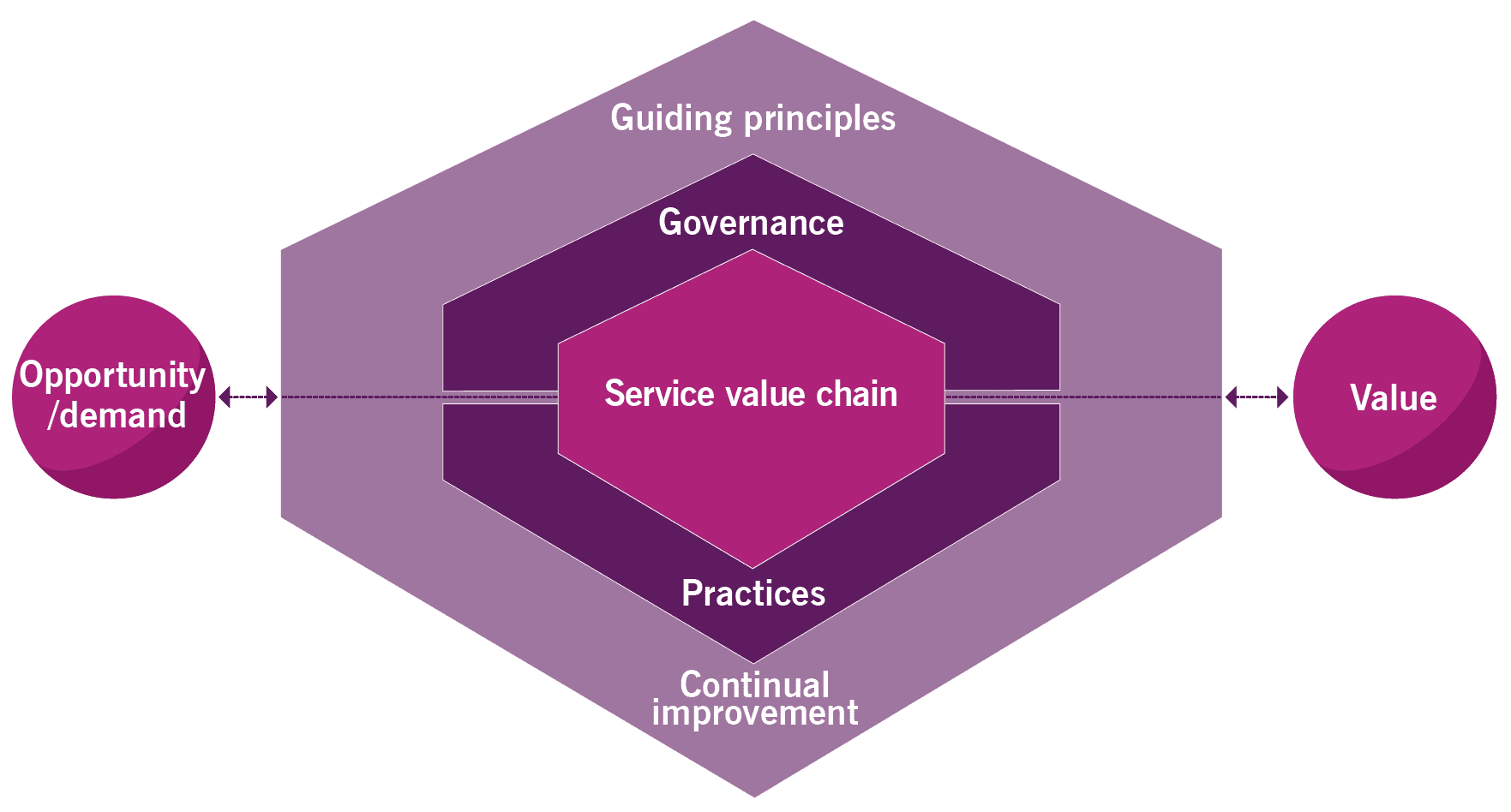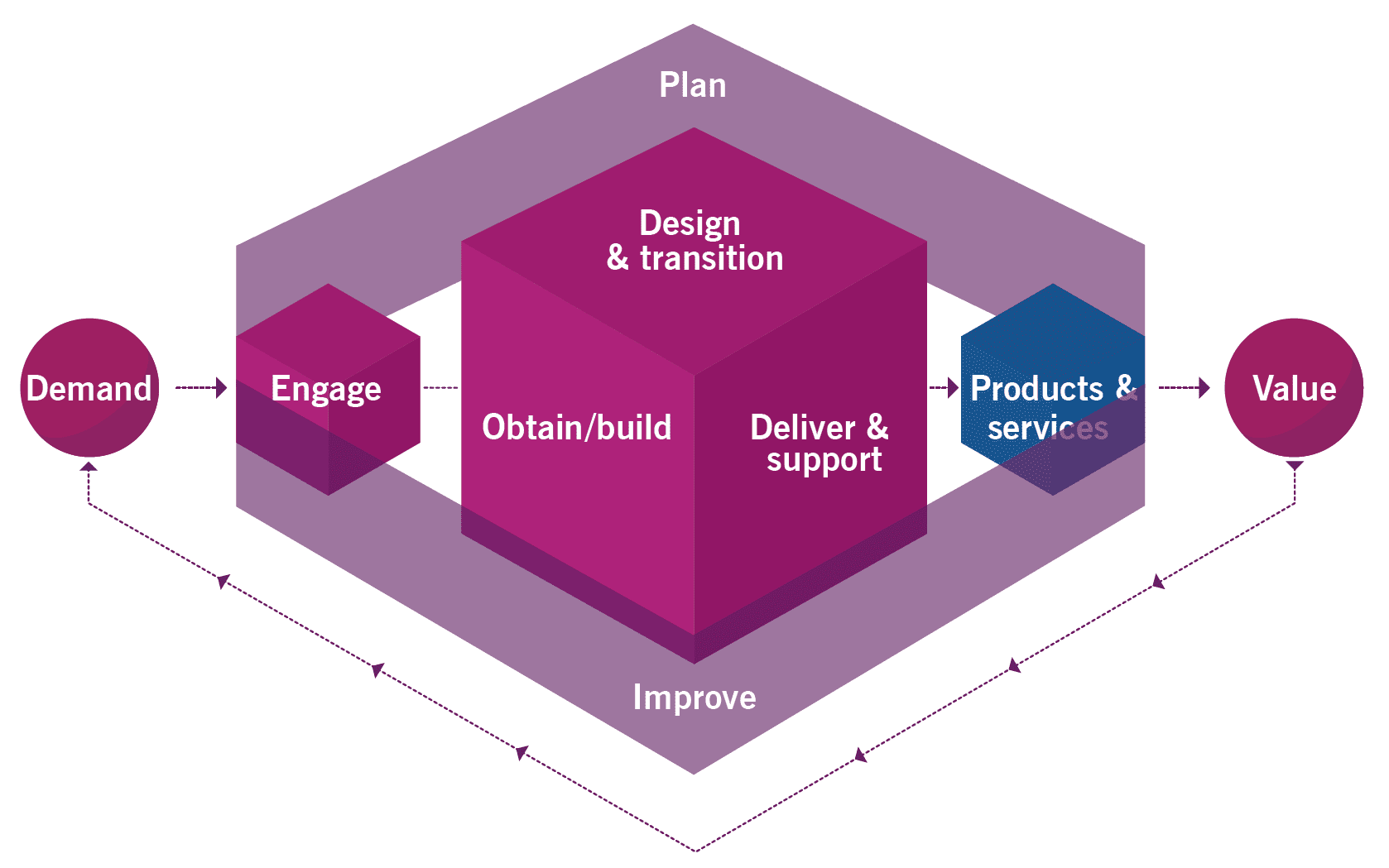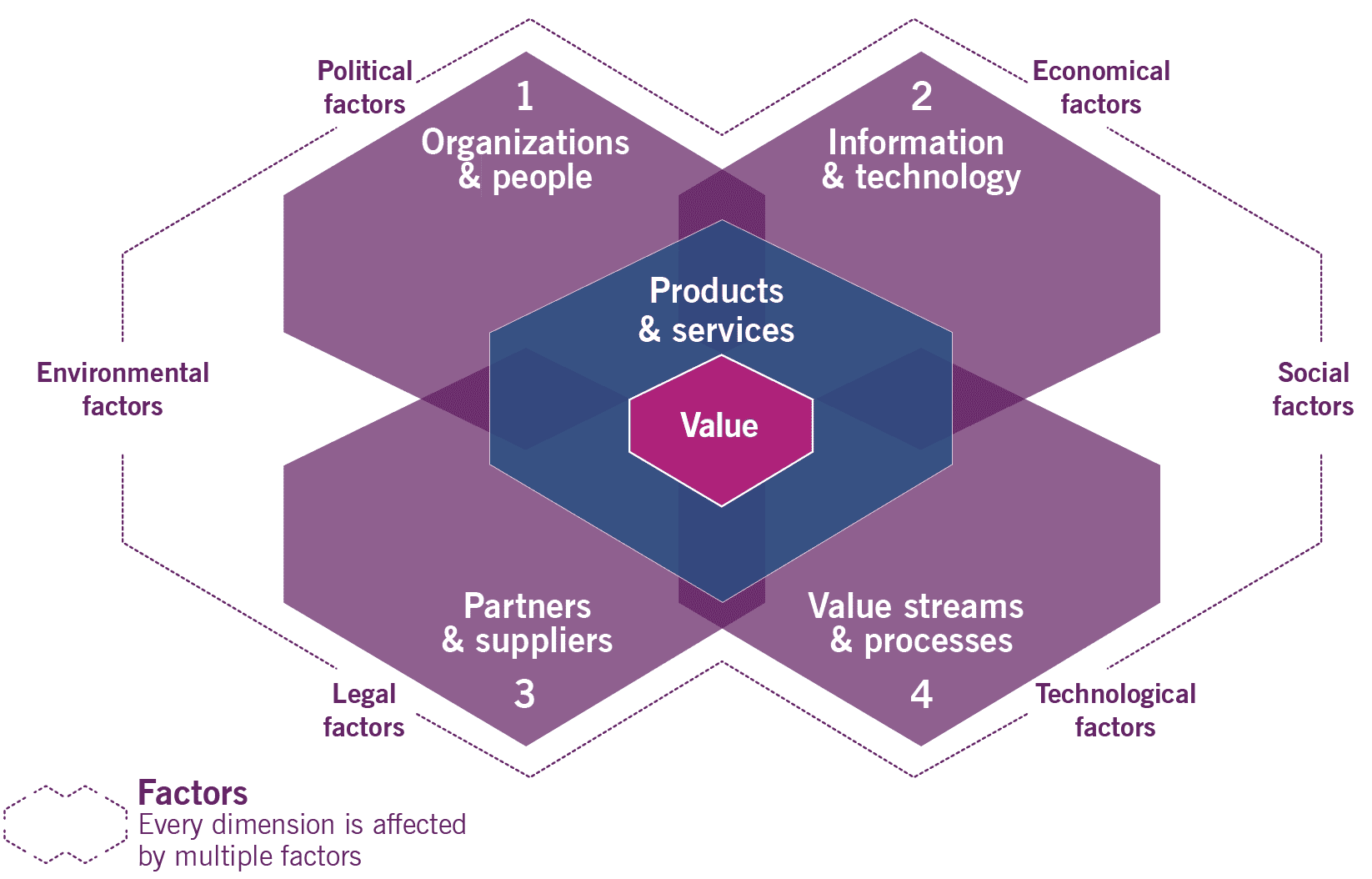The Fundamentals of ITIL
Everything you need to know about this service management best practice framework
12 mins read
If you want to know more about ITIL fundamentals, this article is for you. Your organization might want to adopt IT service management (ITSM) best practices, or you might wish to gain ITIL certification to boost your IT career. Either way, this page is a great way to receive maximum ITIL insight in the shortest time possible. Let's start with a definition of what ITIL is.
What is ITIL?
The official ITIL definition is "...the most widely recognized framework for IT and digitally enabled services in the world." But two important ITIL attributes need to be understood:
- Until 2007, ITIL was an acronym for IT Infrastructure Library. However, the longer-form name was dropped with the publication of ITIL v2. So, when people want to know what ITIL stands for, the answer is simply "ITIL." Of course, it's fine to use phrases such as "ITIL, formerly known as the IT Infrastructure Library."
- Until 2019, ITIL was ITSM best practice, with ITIL being described as the most popular framework of ITSM best practices globally. ITIL 4 moved the focus from ITSM to service management.
The second of these changes comes from the applicability of ITIL outside of IT, with ITIL already being used in the extension of ITSM capabilities to other business functions in what the IT industry calls "enterprise service management." This corporate approach to improving how other business functions work can be described as other business areas using ITSM capabilities to improve performance, services, experiences, and outcomes.
Other key things to know about the ITIL framework
A key attribute of ITIL to understand is that it's a service management framework that offers guidance, not a standard. So, your organization cannot be "ITIL compliant." Nor can ITSM tools. Instead, ITSM tools should be referred to as being ITIL-aligned or similar.
It's important to understand that ITIL isn't just a set of ITSM processes. ITIL 4 was intended to help address this misconception. It replaced ITIL v3/2011's 26 processes with 34 "management practices," defined as "...a set of organizational resources designed for performing work or accomplishing an objective."
ITIL doesn't offer certifications to organizations; it's a people-based certification. The organizational benefit is when the certified people apply their ITIL learnings "back in the office" to improve IT service delivery and support operations and outcomes. For some, this is "ITIL implementation," but ideally ITIL should adopted - recognizing that it's more than a set of ITSM processes.
An ITIL Maturity Model and Assessment can be used to gauge the quality of an organization's ITIL adoption. However, it's likely that managed service providers will adopt this given the statement that "An Axelos endorsement is available for each assessment and provides an independent verification of the rating achieved. This acts as a formal confirmation of the organization's ability to perform as an effective service provider and supports organizations in differentiating themselves for bids and request for proposal (RFP) responses."
How ITIL guidance is created
ITIL has long been the output of collecting IT-industry good practice. This involves leading ITSM and service management industry authorities either being interviewed or writing and reviewing the resulting content.
However, despite the "crowdsourced" approach, ITIL isn't open-source content that's free to all. Instead, the ITIL content is owned by Axelos. Axelos was originally a joint venture between the UK Cabinet Office and Capita plc. Set up to manage, develop, and grow what was called the Global Best Practice portfolio.
PeopleCert acquired Axelos, and thus ITIL and the PRINCE2 IP, in 2021, extending their position as the sole examination institute for Axelos accreditation and examination services. The ITIL IP and brand are tightly protected, and new ways of monetizing the IP are appearing, such as the new 2023 ITIL 4 certifications, which will be explained later.
A history of the ITIL framework
In the late 1980s, the UK Government needed a solution to the IT-project-related issues government departments were experiencing. The first version of the ITIL ITSM best practice framework was created in 1989 (albeit with a different name), but its global popularity came when a second version (called ITIL v2) was published in 2001. Two key publications covered the core ITIL v2 best practice content: Service Delivery and Service Support. Each book covered five ITSM processes.
ITIL v3 was published in 2007 and then "refreshed" in 2011. This later version was called ITIL 2011 but has more recently been called ITIL v3 (2011 Edition) by Axelos. The v3 version of ITIL was a significant shift from ITIL v2. Growing from ten to 26 processes and introducing the concept of the "service lifecycle," which included five elements with associated publications:
- Service strategy
- Service design
- Service transition
- Service operation
- Continual service improvement (CSI).
The 26 ITIL v3 processes were spread across these five service lifecycle elements.
The latest version of ITIL, ITIL 4, was released in early 2019. This was the ITIL 4 Foundation publication and certification. The higher-level certifications were introduced in early 2020, and more certifications have been released since.
The difference between ITIL and ITSM
Before the release of ITIL 4, and the framework's focus moving from ITSM to service management, the easiest way to differentiate between ITIL and ITSM was that ITIL is a "flavor" of ITSM. So, ITIL was a form of ITSM, but there was more ITSM best practice guidance than ITIL. Now that ITIL relates to service management and not just ITSM, this no longer holds true unless an ITSM perspective of the ITIL guidance is taken.
So, an organization can employ various ITSM best practice approaches to improve its IT service delivery and support operations and outcomes - including blending the methods to best suit organizational needs.
Other popular sources of ITSM best practice guidance
Other sources of ITSM best practice guidance include:
- COBIT - this is defined by ISACA as "A framework for the governance and management of enterprise information and technology, aimed at the whole organization." It, therefore, offers more than ITSM guidance.
- FitSM - which is a free "lightweight" standard for ITSM. Although there are costs associated with FitSM certification.
- ISO/IEC 20000 - this is an international service management standard to "establish, implement, maintain, and continually improve a service management system." So, like ITIL, it covers more than ITSM.
- IT4IT - The IT4IT Reference Architecture, an Open Group standard, is defined as "a powerful tool for aligning the strategy and digital product delivery of a Digital Enterprise." Again, it's more than ITSM best practice guidance.
How ITIL 4 changed the traditional ITIL best practice guidance
The move from ITIL v2 to ITIL v3 was considered a big evolution in 2007. However, the move to ITIL 4 was even more significant, reflecting much of what had been happening in the IT industry in the previous decade. The key ITIL 4 changes included:
- The shift in focus from ITSM to service management
- A new focus on value creation (or value co-creation) above all
- The introduction of a service value system and service value chain
- The ITIL v3 processes were replaced by ITIL 4's management practices (which include processes)
- The ITIL v3 service lifecycle was no longer part of the ITIL 4 content
- ITIL 4 added seven guiding principles (based on the ITIL Practitioner Guide's nine guiding principles)
- ITIL v3's four Ps - people, processes, products (technology), and partners - were replaced by ITIL 4's four dimensions of service management.
The ITIL 4 service value system
The ITIL 4 service value system depicts how customer demand for services gets turned into value using:
- The service value chain
- ITIL guiding principles
- Management practices
- Governance
- Continual improvement
These are shown in the Axelos image below.
The ITIL Service Value System

The ITIL 4 service value chain
The service value chain is defined as "an operating model which outlines the key activities required to respond to demand and facilitate value realization through the creation and management of products and services."
It's made up of six repeatable activities:
- Plan
- Improve
- Engage
- Design and transition
- Obtain/build
- Deliver and support.
These activities are shown in the service value chain image below.
The ITIL 4 Service Value Chain

The 7 ITIL 4 guiding principles
The following definitions are taken from the ITIL 4 Foundation publication.
1. Focus on value
"Everything that the organization does needs to map, directly or indirectly, to value for the stakeholders. The focus on value principle encompasses many perspectives, including the experience of customers and users."
2. Start where you are
"Do not start from scratch and build something new without considering what is already available to be leveraged. There is likely to be a great deal in the current services, processes, programs, projects, and people that can be used to create the desired outcome. The current state should be investigated and observed directly to make sure it is fully understood."
3. Progress iteratively with feedback
"Do not attempt to do everything at once. Even huge initiatives must be accomplished iteratively. By organizing work into smaller, manageable sections that can be executed and completed in a timely manner, it is easier to maintain a sharper focus on each effort. Using feedback before, throughout, and after each iteration will ensure that actions are focused and appropriate, even if circumstances change."
4. Collaborate and promote visibility
"Working together across boundaries produces results that have greater buy-in, more relevance to objectives, and increased likelihood of long-term success. Achieving objectives requires information, understanding, and trust. Work and consequences should be made visible, hidden agendas avoided, and information shared to the greatest degree possible."
5. Think and work holistically
"No service, or element used to provide a service, stands alone. The outcomes achieved by the service provider and service consumer will suffer unless the organization works on the service as a whole, not just on its parts. Results are delivered to internal and external customers through the effective and efficient management and dynamic integration of information, technology, organization, people, practices, partners, and agreements, which should all be coordinated to provide a defined value."
6. Keep it simple and practical
"If a process, service, action or metric fails to provide value or produce a useful outcome, eliminate it. In a process or procedure, use the minimum number of steps necessary to accomplish the objective(s). Always use outcome-based thinking to produce practical solutions that deliver results."
7. Optimize and automate
"Resources of all types, particularly human resources, should be used to their best effect. Eliminate anything that is truly wasteful and use technology to achieve whatever it is capable of. Human intervention should only happen where it really contributes value."
The ITIL 4 management practices
The ITIL 4 Foundation publication defines management practices as "...a set of organizational resources designed for performing work or accomplishing an objective."
The 34 ITIL 4 management practices replace the 26 ITIL v3 processes (and four functions). This ITIL 4 change elevates individual and organizational thinking beyond the ITSM processes that were most remembered in ITIL v2 and ITIL v3.
The ITIL 4 management practices cover three areas:
- General management
- Service management
- Technology management.
Some practices are new, such as organizational change management, IT asset management, and two of the three technology management practices. Others are name changes, with some content changes, too. Such as capacity management to capacity and performance management, change management to change enablement (initially change control), and event management to monitoring and event management. Some practices are completely changed from their ITIL v3 process predecessors - knowledge management, for example.
The table below shares the 34 management practices organized by practice type.
The 34 ITIL 4 Management Practices
| General management practices (14) | Service management practices (17) | Technical management practices (3) |
Architecture management |
Availability management |
Deployment management |
Continual improvement |
Business analysis |
Infrastructure and platform management |
Information security management |
Capacity and performance management |
Software development and management |
Knowledge management |
Change enablement |
|
Measurement and reporting |
Incident management |
|
Organizational change management |
IT asset management |
|
Portfolio management |
Monitoring and event management |
|
Project management |
Problem management |
|
Relationship management |
Release management |
|
Risk management |
Service catalog management |
|
Service financial management |
Service configuration management |
|
Strategy management |
Service continuity management |
|
Supplier management |
Service design |
|
Workforce and talent management |
Service desk |
|
Service level management |
||
Service request management |
||
Service validation and testing |
Each ITIL 4 management practice has its own set of critical success factors (CSFs) called practice success factors (PSFs) and key performance indicators (KPIs) and metrics. For example, in the incident management practice, the PSFs include:
- Detecting incidents early
- Resolving incidents quickly and efficiently
- Continually improving incident management.
The metrics include:
- The time between incident occurrence and detection
- The percentage of incidents detected via monitoring and event management
- The time between incident detection and acceptance for diagnosis
- The number of reassignments
- The percentage of waiting time in the overall incident handling time
- The first-time resolution rate
- Meeting the agreed resolution time
- User satisfaction with incident handling and resolution
- The percentage of incidents resolved automatically
- The percentage of incidents resolved before being reported by users
- The percentage of incident resolutions using previously identified and recorded solutions
- The percentage of incidents resolved using incident models
- The improvement of the key practice indicators over time
- The balance between the speed and effectiveness metrics for incident resolution.
Continual improvement
The name of ITIL v3/2011's continual service improvement was changed to continual improvement to reflect service management improvement applying to more than service improvement. However, it was more than simply a name change, with continual improvement introduced as an ITIL 4 management practice rather than one of the five service lifecycle elements and a separate ITIL v3 publication.
Governance
ITIL 4 Foundation focuses on three key governance aspects:
- Evaluation of change
- Direction
- Monitoring organizational performance.
ITIL 4's four dimensions of service management
In ITIL 4, the four dimensions of service management replaced the ITIL v3/2011 four Ps (people, processes, products (technology), and partners). These dimensions are shown in the Axelos image below.
The Four Dimensions of Service Management

The various ITIL 4 certifications
The initial ITIL 4 certifications were ITIL 4 Foundation in 2019 and Managing Professional, Strategic Leader, and ITIL Master in 2020.
The core modules for certifications are:
- ITIL Foundation
- ITIL Managing Professional
- Create, Deliver & Support
- Drive Stakeholder Value
- High Velocity IT
- Direct, Plan & Improve
- ITIL Strategic Leader
- Direct, Plan & Improve
- Digital & IT Strategy.
Four ITIL 4 Specialist "extension modules" have since been added to the ITIL 4 certification portfolio:
- Acquiring & Managing Cloud Services
- Business Relationship Management
- IT Asset Management
- Sustainability in Digital & IT.
In 2023, Axelos added the ITIL Practice Manager certification. This certification offers a different progression path for ITIL 4 Foundation certification holders. They can now receive a manager-level ITIL 4 certification that's aligned to one of three areas:
- Monitor, Support and Fulfil - which includes the incident management, monitoring and event management, problem management, service desk, and service request management practices.
- Plan, Implement and Control - which includes the change enablement, deployment management, IT asset management, release management, and service configuration management practices.
- Plan, Implement and Control - which includes the change enablement, deployment management, IT asset management, release management, and service configuration management practices.

